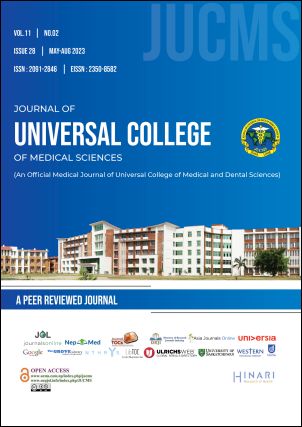In-Vitro Anti-Diabetic Activity and Phytochemical Screening of Ethanolic extract of Calotropis gigantea (Linn)
DOI:
https://doi.org/10.3126/jucms.v11i02.58064Keywords:
Anti-diabetic, Metformin, Sitagliptin, Acarbose, α-amylase and Calotropis giganteaAbstract
INTRODUCTION Diabetes Mellitus (DM) is metabolic disorder characterized by hyperglycaemia due to defect insulin release from pancreas and insulin resistance. The present study was aimed to screen the phytoconstituent present in leaf extract and evaluate α- amylase inhibitory activity of ethanolic extract of Calotropis gigantea leaf. Calotropis gigantea also known as crown flower is rich in phytochemicals like alkaloids, saponins, steroids, flavonoids and glycosides. It is used for asthma, bronchitis and dyspepsia, dried whole plant is a good tonic.
MATERIAL AND METHODS About 58.45g coarse powder of Calotropis gigantea leaves was extracted with ethanol using Soxhlet apparatus. Then the phytochemical screening of ethanolic extract was done. Different concentration (0.1mg/ml to 1mg/ml) of ethanolic extracts of leaves, acarbose, sitagliptin and metformin was prepared, and all the concentration were evaluated for α- amylase inhibitory activity through spectrophotometric method.
RESULTS Maximum inhibition of α- amylase was shown by acarbose at concentration of 1mg/ml and found to be 78.787 ± 0.00240 % whereas plant extract at concentration of 1mg/ml showed inhibition of α- amylase activity 54.6296 ± 0.00282 %. Percentage inhibition of α-amylase activity by plant extract was found to be dose dependent.
CONCLUSION It was concluded that Calotropis gigantea leaves possess some bioactive compounds which were responsible for controlling blood glucose level by inhibiting α-amylase and its identification, isolation and characterization may lead to development of newer drugs with lesser side effects.
Downloads
Downloads
Published
How to Cite
Issue
Section
License
Copyright (c) 2023 Journal of Universal College of Medical Sciences

This work is licensed under a Creative Commons Attribution-NonCommercial 4.0 International License.
Authors have to give the following undertakings along with their article:
- I/we declare that this article is original and has not been submitted to another journal for publication.
- I/we declare that I/we surrender all the rights to the editor of the journal and if published will be the property of the journal and we will not publish it anywhere else, in full or part, without the permission of the Chief Editor.
- Institutional ethical and research committee clearance certificate from the institution where work/research was done, is required to be submitted.
- Articles in the Journal are Open Access articles published under the Creative Commons CC BY-NC License (https://creativecommons.org/licenses/by-nc/4.0/)
- This license permits use, distribution and reproduction in any medium, provided the original work is properly cited, and it is not used for commercial purposes.




